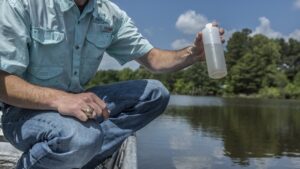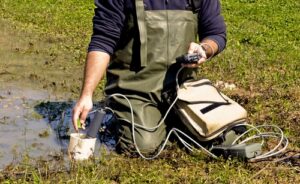By Matt Ward
In the interest of full disclosure it should be noted that my academic background is in biochemistry so I get pretty excited about water quality issues. That being said, this stuff really is important even if the details can’t quite inspire excitement like trophy largemouth.
Water quality issues across the nation go largely ignored as lake managers continue to reactively treat the symptoms of poor water quality.
 Time after time, pond weeds and algae growth run rampant while water quality issues that drive this growth are not addressed. Fish kills occur and aeration systems are installed all while water quality issues that should be addressed go ignored.
Time after time, pond weeds and algae growth run rampant while water quality issues that drive this growth are not addressed. Fish kills occur and aeration systems are installed all while water quality issues that should be addressed go ignored.
Sometimes a little water quality work is all it takes to transform a water body and generate a healthy fishery with lower net annual input requirements. In other cases, fundamental water quality issues need to be addressed for fishery management techniques to even stand a chance. Let’s take a look at the four most important pond water testing parameters and how they can be adjusted to create a healthy fishery.
Turbidity
Turbidity represents the ability of a water body to absorb light that penetrates the surface. Turbidity is measured by peering into a pond or lake and determining the depth at which a highly contrasting object (professionally we use a secchi disk) disappears from view.
This depth is reported as the lake or pond’s visibility or turbidity. Turbidity is generally caused by one of two factors (though turbidity can certainly be altered with commercially available dyes): plankton or suspended solids (especially clays).
Turbidity from plankton represents primary productivity in an aquatic system and is generally desirable in most cases.
A highly productive pond or lake should have 18-24 inches of visibility. This level of turbidity will support high levels of fish production while avoiding increased risk of a plankton bloom crash which could easily lead to a fish kill. If a given lake has substantially less than 18 inches of visibility steps should be taken to reduce plankton production to protect the fishery.

Turbidity caused by suspended solids like clay particles are another story. Muddy water shades out the bottom sediments and supports low levels of primary productivity. A pond with turbidity from suspended solids will not support as great of a fish population as a similar pond with lower turbidity. This pond should generally be cleared.
To settle out turbid water, a clearing test should be run to determine how your water can be cleared. Most muddy water can be cleared with a flocculent like aluminum sulfate, but some waters are simply muddy from getting stirred up by cattle or even an overabundance of bottom fish like catfish or carp. In some cases a pond will need to be killed out in order to reset the fish populations and enable better water clarity to prevail, other times agricultural practices may need to be modified a bit to decrease turbidity.
Nutrients
The next water quality factor we’ll consider are nutrients. Ponds and lakes are nutrient sinks. All the basic nutrients in the landscape run down hill with the rainwater and end up in the pond.
In some cases, nutrient levels are low and a fishery’s productivity will need to be improved through fertilization. But in many other cases too much inflow means that pond managers must deal with endless cycles of growth of vegetation, algae, or phytoplankton.
In extreme cases, excess nutrients can lead to regular fish kills as excessive growth can easily absorb too much oxygen during the night or during cloudy weather. Excess growth can be temporarily reduced by targeted treatments, but ultimately growth should be curtailed by nutrient management.
 The first step in managing nutrients is to understand where the bulk of a pond or lake’s excess nutrients are coming from. The most likely sources are applied fertilizers (both inorganic and organic), high nutrient well water, and direct animal waste.
The first step in managing nutrients is to understand where the bulk of a pond or lake’s excess nutrients are coming from. The most likely sources are applied fertilizers (both inorganic and organic), high nutrient well water, and direct animal waste.
Mitigation is both direct and indirect. Direct management might include applying fertilizers farther back from the pond, leaving a band of unfertilized shoreline around the pond or lake. It might call for reducing the fertilizer application rate or reducing the amount of well water inputs you use or even drilling another well to tap into a different aquifer. Other direct management techniques could involve herd control such as reducing herds or fencing them off of the pond or lake.
Indirect management, on the other hand, seeks to absorb the nutrients that are coming into the water body. This type of management might include establishing a buffer of marginal vegetation or other beneficial aquatic plants to soak up available nutrients. Another technique is to stocking forage that takes better advantage of phytoplankton helping to convert plankton bloom into fish biomass.
Another indirect technique is to apply inorganic minerals that deactivate nutrients like phosphorous, or using activated charcoal to directly absorb dissolved nutrients.
Some pond managers prefer to use aeration and micronutrients to create a better environment for beneficial bacteria that can also be used to process excess nutrients.
Nutrient management isn’t rocket science but best management practices will normally require a little professional direction. It’s important to prioritize the right management tools in your specific situation to best impact nutrient loading.
We’ll continue exploring water quality and pond water testing as part of comprehensive lake and pond management in next week’s posting, focusing on alkalinity and water hardness.
Why Choose Lochow Ranch for Pond & Lake Management
Serving Texas, Oklahoma, Arkansas and Louisiana, Lochow Ranch Pond & Lake Management proudly puts more than two decades of experience to work for you. Our team includes biologists, technicians and other professionals with deep expertise in pond and lake management services.
Check us out if you are considering building a lake, looking for pond stocking services, to buy fish for a pond, or getting professional pond management and maintenance or fishery management. Our services include lake design, pond construction, pond renovation, pond water testing, electrofishing, pond stocking, control of pond weeds, and pond liming and fertilizing. Let us help you build your dream pond that will delight your family and friends for generations to come.
Click here to get in touch to get started today.
Matt Ward is a Fishery Biologist for Lochow Ranch Pond & Lake Management. He has a Master of Science in Biochemistry from Texas A&M University and has worked in fisheries management in Texas for 15 years. He brings a passion for good science and an interdisciplinary approach to the natural sciences to help property managers steward their aquatic resources and achieve management objectives.


Recent Comments